Fraxel Laser For Acne Scars
Many of us struggle with acne throughout our lives, which, if not adequately treated, can leave us with permanent acne scars. Acne scars can be even harder to treat than the acne lesions themselves and can leave one feeling self-conscious and frustrated. The most common type of acne scars are atrophic scars, or depressions that form due to insufficient collagen production during the healing process. Luckily, advancements in cosmetic dermatology have led to the development of the Fraxel laser, a gold-standard laser treatment for acne scars. Dr. Michele Green has over 25 years of experience treating patients with acne scars and often uses the Fraxel laser in her treatment plan to create clear, radiant skin.
The Fraxel laser is a non-ablative, non-invasive laser resurfacing treatment that is FDA-approved to revitalize skin, even skin tone and texture, and reduce the appearance of acne scars on the face, neck, chest, back, arms, and legs. The laser uses fractional laser technology to boost collagen in the skin, which can reduce the appearance of acne scarring, fine lines, and hyperpigmentation, among other skin conditions. As the laser only treats a fraction of the treatment area at a time, the surrounding skin is left unharmed, allowing for faster recovery and less downtime. After a series of Fraxel treatments, you can expect an even textured, rejuvenated skin with long-lasting results. If you are tired of your acne scars and ready to treat them with the Fraxel laser, Dr. Green is here to help.
Dr. Michele Green in New York City is an internationally renowned board-certified cosmetic dermatologist with over two and a half decades of experience providing the best non-invasive treatment options, including Fraxel, to her patients from around the globe. Super Doctors, New York Magazine, and Castle Connolly consistently voted Dr. Green one of New York’s best physicians. When you consult with Dr. Green for your acne scar treatment at her private dermatology office in the Upper East Side neighborhood of Manhattan, you will have the opportunity to discuss your specific skin concerns and aesthetic goals with her. Dr. Green will work with you to create a Fraxel rejuvenation plan that best suits your skin and delivers the ideal cosmetic results you are after.
What is Fraxel Laser Treatment?
The Fraxel laser is the first fractionated laser of its kind that is FDA-approved for facial rejuvenation. Fraxel laser treatment uses unique technology to create thousands of microscopic injuries with absolute precision deep within the dermis. The Fraxel laser treats a fraction of the treated area at a time, leaving the surrounding tissue unaffected. As the laser treatment heats the dermis, it stimulates the body’s natural healing process to produce new collagen for expedited rejuvenation. After a series of treatment sessions spaced one month apart, the Fraxel laser can create rejuvenated, smooth skin with long-lasting results. There are three types of Fraxel lasers: Fraxel Dual, Fraxel Repair, and Fraxel Restore. Dr. Green employs the Fraxel Dual laser in her private Upper East Side dermatology office for acne scar treatment.
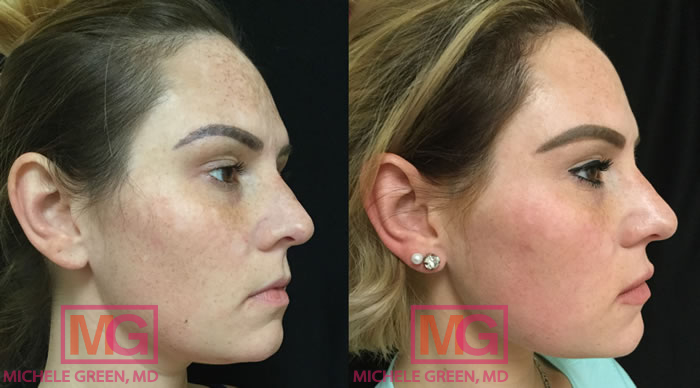
Fraxel combined with Juvederm
What is the Fraxel Dual Laser?
The Fraxel Dual laser is essentially two lasers in one: the Erbium laser, which operates at a 1550 nm wavelength, and the Thulium laser, which operates at a 1927 nm wavelength. With two different wavelengths of fractional laser energy on one device, the Fraxel Dual laser can treat a variety of skin conditions by using each wavelength separately or within the same treatment session. Each of the two wavelength settings available on the Fraxel Dual Laser targets various skin conditions, with the 1927 nm setting best for pigmentation and superficial skin resurfacing and the 1550 nm setting best for acne scars, deep lines and wrinkles, and uneven skin texture. The Fraxel Dual is equipped with a Zimmer device that emits bursts of cool air during the procedure for maximum patient comfort.
Fraxel Laser 1550 for Acne Scars
One of the two laser beams in the Fraxel Dual laser, the 1550nm wavelength, uses Erbium technology to reach deep into the dermis layers to jumpstart new collagen production. This, in turn, can tighten and smooth the skin, improving the appearance of acne scars, surgical scars, fine lines, wrinkles, and stretch marks. Typically, acne scars require three to five Fraxel laser treatments, which are approximately one month apart. There is minimal downtime with some redness after treatment for 48 hours.
Fraxel Laser 1927 Wavelength
The second beam in the Fraxel Dual laser is known as the 1927nm wavelength. It’s a Thulium laser that can remove pigment-related issues, including brown spots, age spots, and sunspots. It is the gold standard in pigmentation removal and sun damage. The Thulium laser delivers targeted heat energy to chromophores, or colored elements within skin cells, to eliminate pigmented spots. Depending on the amount of pigmentation and age spots, it typically takes two to three sessions, spaced one month apart, to remove facial discoloration from sun damage. Mild redness is common for 48 hours after the procedure, followed by three to seven days of slight peeling where the skin feels like rough sandpaper.
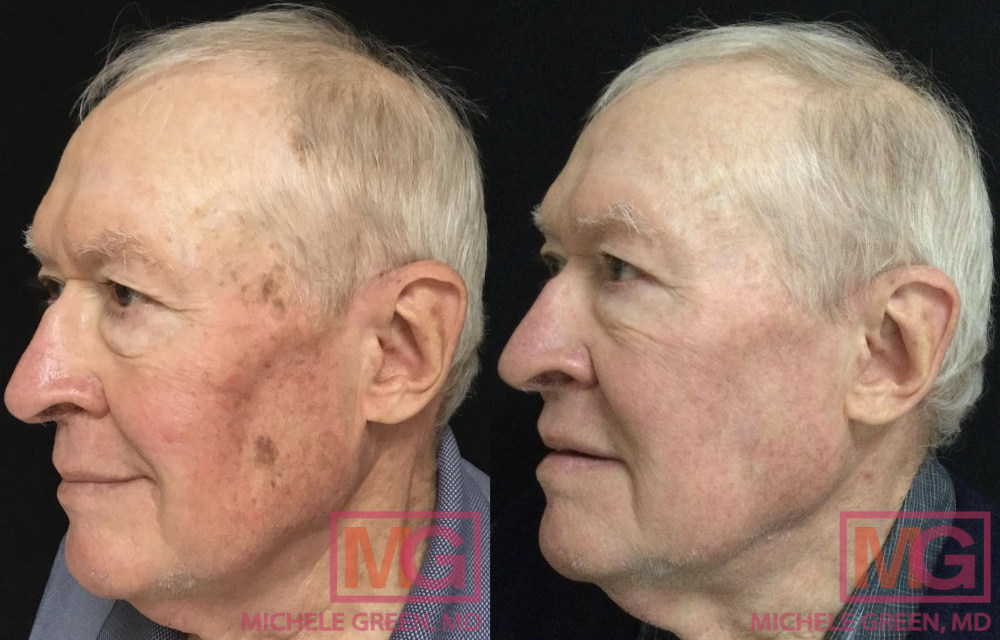
Which conditions does the Fraxel Laser Treat?
The Fraxel Laser can treat a variety of skin conditions and can be used on multiple areas of the body, including the face, neck, décolletage, hands, back, arms, and legs. The 1550nm Erbium laser can remove various atrophic scars, including ice pick and boxcar acne scars, surgical scars, and scars from injury. It’s also excellent at creating a more youthful appearance by reducing the appearance of fine lines and wrinkles, shrinking enlarged pores, improving skin tone and texture, and reducing the appearance of stretch marks. Lastly, the 1927nm Thulium laser can reduce pigment-related issues, such as sun damage, age spots, brown spots, freckles, hyperpigmentation, and skin discoloration. Treating melasma with the Fraxel laser is not advised, as this can worsen the existing hyperpigmentation and ultimately make it more difficult to remove.
When it comes to acne scars, Dr. Green will use the Erbium laser to remove the appearance of acne scarring on the face as well as improve the evenness of your skin texture and the appearance of fine lines and wrinkles. However, if you are also dealing with the appearance of sun damage, dark spots, actinic keratosis, or discoloration, a hybrid treatment between the Erbium and Thulium lasers can be custom-made. Dr. Green often uses a combined treatment between both beams for comprehensive results and curates the specific laser concentrations to best serve your needs.
Is Fraxel ablative?
There are two overarching types of laser treatments: ablative laser treatment, which involves the vaporization of the outer layer of skin, and non-ablative laser treatment, which causes controlled damage to the inner layer of skin while leaving the outer layer undamaged. Fraxel lasers can be ablative or non-ablative depending on the type of Fraxel laser used. The Fraxel Repair is an ablative CO2 laser used for dramatic skin resurfacing, eliminating the entire epidermal layer to promote skin cell turnover and collagen production. While ablative lasers produce more dramatic results, the recovery time is significant, requiring up to 2 weeks of downtime following the treatment. Additionally, ablative lasers increase the risk of side effects such as scarring or hyperpigmentation. On the other hand, the Fraxel Dual Laser used by Dr. Green is a non-ablative laser that does not harm the outer layer of the skin. Since the Fraxel Dual laser only treats a fraction of the treatment area at a time, the surrounding skin is left untouched, allowing for faster recovery times and minimal downtime or side effects.
Can you use Fraxel for scars?
The Fraxel Dual laser is a highly effective treatment option for many forms of scarring, including acne scars, ice pick and boxcar scars, and surgical and injury scars. Acne scarring is a prevalent skin condition, with over 80% of people experiencing acne breakouts between the ages of 11 and 30 and 1 in 5 developing some form of acne scar due to their breakout. Several risk factors for developing acne scars after a breakout, including deep infection in the nodule or cyst, inhibit the proper collagen production during the healing process, leading to either atrophic or hypertrophic acne scars. The 1550 nm Erbium setting is the most effective for addressing any scarring by penetrating deep into the dermal layer of the skin to produce new collagen. After a series of treatment sessions, you can expect a minimized appearance of scars and clearer, brighter, more youthful-looking, healthy skin.
What does the procedure entail for the Fraxel laser?
To prepare for Fraxel laser treatment, discontinue using any retinoids for one week prior to your appointment. Your skin should not be tan or have self-tanner, as it may interfere with the results of your treatment or can cause a burn to the treated area. Prior to your Fraxel laser treatment, Dr. Green will prescribe a topical numbing cream to be applied to the treated area. If you have a history of cold sores, Dr. Green will prescribe Valtrex to be started a day before your procedure to minimize the risk of a herpetic outbreak.
When you visit Dr. Green for your Fraxel procedure, the designated treated area will be cleaned, and photographs may be taken for your record. Protective goggles will be placed, and Dr. Green will deliver the designated laser energy in passes to your skin. You will feel bursts of heat during your treatment and may experience slight stinging; however, the Zimmer device will simultaneously emit bursts of cool air to maximize comfort. Most appointments last around 15 minutes, but this varies depending on the size of the treatment area and the depth of the acne scars being treated.
What is the aftercare for the Fraxel laser?
After your Fraxel laser treatment, you can resume regular activity shortly. After treatment, avoid retinoids, exfoliants, or any other skincare products that might aggravate the skin until the treatment area is fully healed. These include exfoliants (alpha or beta hydroxy acids), hydroquinones, and retinoids. Patients treated exclusively for acne scars under the 1550nm setting may experience mild swelling or redness resembling a sunburn for 48 hours post-treatment. If treated with the 1550 and 1927 wavelength beams, you’ll experience sensitive skin for 5-7 days. Within the first 48 hours post-treatment, your skin will appear as if it has a sunburn; afterward, the top layer will peel, revealing a healthy new layer of skin. It is essential to keep the skin moisturized and practice proper sun protection, avoiding sun exposure and using a broad-spectrum sunscreen with an SPF of 50 or higher, as the laser sensitizes the skin to the sun. If you wear makeup, you must still apply sunscreen underneath, even if your makeup contains SPF.
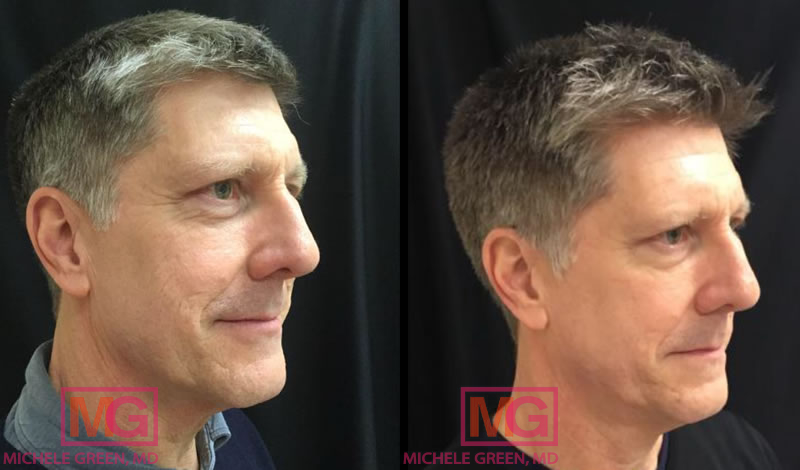
What are the potential side effects of Fraxel laser?
There are very few side effects associated with Fraxel laser treatment. Most patients experience mild redness or swelling after the treatment that resolves on their own 48 hours post-treatment. Patients treated with the 1927nm Thulium laser will experience peeling akin to rough sandpaper for another three to five days. Using a daily moisturizer and sunscreen regimen can prevent further discomfort. MGSKINLABs, Dr. Green’s highly coveted skincare line, offers access to a Recovery Cream to help prevent skin damage post-treatment. Patients with a history of acne breakouts may be prescribed an oral antibiotic to be taken after treatment. Patients with a history of herpes simplex (cold sores) will be pre-treated with Valtrex to avoid an outbreak.
In rare cases, side effects of Fraxel laser include scarring, hyperpigmentation, and infection. It is essential to have your Fraxel laser treatment performed by an expert such as board-certified dermatologist Dr. Michele Green to avoid any adverse side effects. Dr. Green does not recommend Fraxel laser skin resurfacing for those with melasma, as it can worsen the pigmentation from facial melasma. Additionally, the Fraxel laser is only safe for those with skin types I, II, and III; those with darker skin types should avoid using the Fraxel laser due to the increased risk of hyperpigmentation and discoloration. Dr. Green can recommend various alternative acne scar treatment options, such as the eMatrix laser, Vivace laser, and other radiofrequency lasers.
How many Fraxel treatments for acne scars?
When treating acne scars with Fraxel laser skin resurfacing, predicting how many treatment sessions will be needed for a given patient can be challenging. This is because everyone responds somewhat uniquely to the laser treatment and will present with varying severity of acne scars. Patients with mild to moderate acne scars require fewer treatment sessions than those with more severe scars. Typically, patients treated with Fraxel for acne scars will require three to five treatment sessions of Fraxel, spaced about four weeks apart, to achieve their ideal cosmetic results. When you consult with Dr. Green at her private dermatology office in the Upper East Side neighborhood of Manhattan regarding your acne scar treatment protocol, she will work with you to determine the treatment modalities that will be incorporated and the approximate number of sessions required.
How painful is Fraxel for acne?
The Fraxel laser is not painful for treating acne scars. Dr. Green will prescribe a topical numbing cream to be applied to the treatment area one hour before your procedure. Additionally, the Fraxel Dual laser is equipped with a Zimmer to emit bursts of cool air for maximum comfort. Patients typically feel slight stinging or heat during the procedure.
How much does acne scar Fraxel treatment cost?
The cost of Fraxel treatment for acne scars varies depending on the size of the treatment area and the severity of the condition. Additionally, the price will vary depending on whether you have an expert performing your laser treatment, an unqualified technician at a clinic, or a Medspa overseeing the procedure. On average, a Fraxel laser treatment session for facial rejuvenation is around $1500. While a Medspa may be more cost-effective, it is essential to complete your Fraxel treatment with a board-certified dermatologist such as Dr. Green to ensure that your acne scar treatment is both safe and effective.
Can I get Fraxel while I still have acne?
It is best to have your acne under control before you take your Fraxel laser treatment. Any type of laser treatment can exacerbate active acne lesions. Patients should treat the acne breakouts first before any acne scar treatment to prevent acne scars from forming after treatment has concluded. For active acne, Dr. Green can prescribe topical or oral medications, depending on the type and severity of your acne. Additionally, in-office treatments, including HydraFacials, V-Beam laser, photodynamic therapy, and acne surgery, can be performed to reduce acne on the skin. If you want to get your acne under control before treatment with Fraxel, consult with Dr. Michele Green, who will thoroughly assess your skin and medical history to create a treatment protocol that best suits your skin concerns.
Is Fraxel better than CO2 for acne?
Fraxel and CO2 (Carbon Dioxide) are two different laser resurfacing treatments used to address skin concerns such as acne scars, fine lines, wrinkles, age spots, and sunspots. The Fraxel laser is a non-ablative laser that does not harm the skin; instead, it delivers fractionated energy into the dermis layer to stimulate the production of new collagen for smoother, even-textured skin. The Fraxel laser treats a fraction of the targeted area at a time, allowing for rapid healing and minimal side effects. A standard CO2 laser is an ablative laser that creates thermal injury in the skin, leading to the removal of the superficial layer of the skin. This controlled heat injury stimulates collagen in the deeper layers of the skin to create tighter, smoother skin.
The CO2 laser is a much more aggressive laser and has much more downtime and potential side effects. CO2 laser is not recommended for skin of color as it can cause hyperpigmentation and hypopigmentation. CO2 laser creates more immediate cosmetic results due to its ability to vaporize the top layer of skin; however, the aggressiveness of the CO2 laser results in longer recovery times of up to six weeks and increased risk of adverse side effects such as scarring, hyperpigmentation, and hyperpigmentation. A series of Fraxel laser treatments can produce cosmetic results similar to those of the CO2 laser, with a series of treatments and without downtime. Dr. Green generally recommends the Fraxel laser due to its safety and efficacy in treating acne scars.
Is Fraxel better than IPL for acne scars?
Yes! Fraxel laser is the gold standard for removing pigmentation. IPL (intense pulsed light) treatment uses different wavelengths of light to treat a multitude of skin conditions, including acne scars and pigmentation. The light emitted is delivered to the dermal layer of the skin and absorbed by its target, such as pigmented cells or blood vessels, for facial rejuvenation. For acne scars, the emitted light is converted to heat energy deep within the dermis to trigger the body’s natural wound-healing process and stimulate new collagen production for smoother skin. The Fraxel laser works by emitting fractional laser energy that is converted to heat energy in the dermal layer of the skin to promote collagen production. However, the fractionated laser energy creates microscopic columns that only treat a fraction of the skin at a time, leaving the surrounding skin unaffected and reducing recovery time. Additionally, the Fraxel laser typically treats acne scars in fewer sessions than IPL.
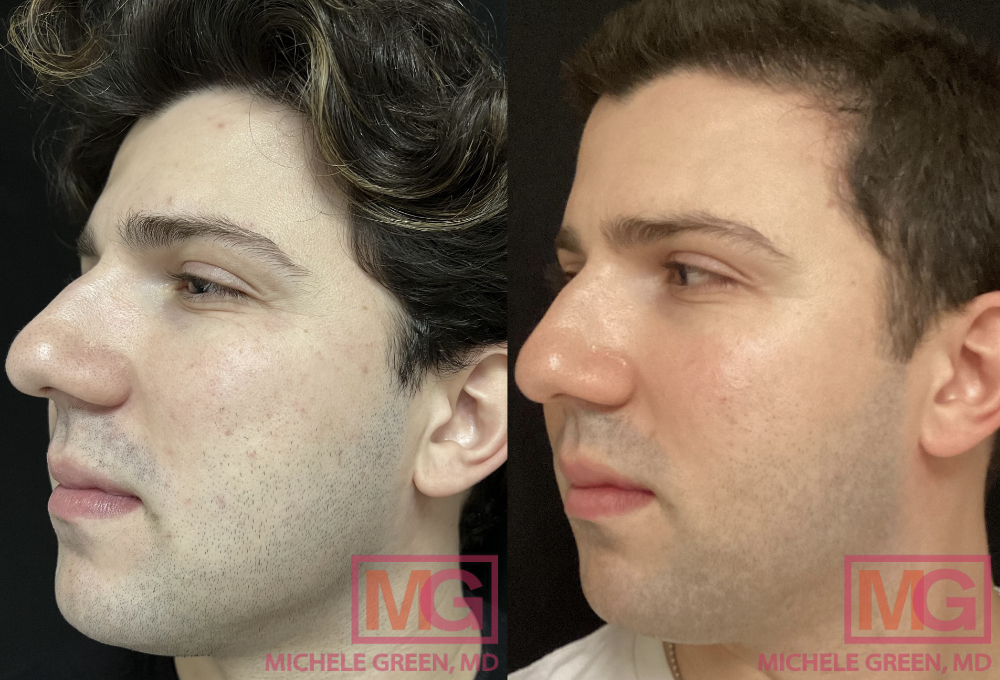
Before and after 2 Voluma, 1 Restylane, and 1 Fraxel for acne scars
Is Fraxel laser or Microneedling better for acne scars?
Both Fraxel and microneedling lead to an increase in new collagen synthesis in the skin. Microneedling, also known as collagen induction therapy, utilizes tiny, surgical-grade needles to create superficial micro-injuries in the skin. This stimulates the body’s natural wound-healing process and the production of new collagen to smooth the skin and reduce the appearance of acne scars. Unlike microneedling, Fraxel delivers fractional laser energy deep within the dermis to heat the skin and promote collagen production. Both Fraxel and microneedling are excellent treatment options for acne scar treatment; however, the Fraxel laser is better suited for treating deeper acne scars, as microneedling affects the skin superficially. Often, Dr. Green may recommend that patients undergo microneedling following Fraxel to maintain the results of the treatment.
Fraxel vs. Pixel laser for acne scars
Similarly to the Fraxel laser, the Pixel laser is a non-ablative fractionated laser that can treat such skin conditions as fine lines, wrinkles, uneven skin texture, hyperpigmentation, enlarged pores, surgical scars, and acne scars. The main difference between the Fraxel laser and the Pixel laser is the wavelength intensity and depth of penetration. Where the Fraxel laser has two wavelengths – 1927 and 1550 nm – the Pixel laser has one: 2940 nm. While the Pixel laser is an effective option, Dr. Green prefers the Fraxel laser as the two wavelengths allow more cosmetic skin conditions to be addressed.
Is Fraxel permanent for acne scars?
The Fraxel laser reduces the appearance of acne scars, effectively minimizes their appearance, and has long-lasting results. For most patients, the full effects of the treatment may not be visible until three to five treatment sessions have been completed. Afterward, most patients require maintenance or touch-up appointments every couple of years to keep the results from treatment. Results are better maintained when patients practice good skincare following the procedure by always wearing SPF 30 or higher sunscreen and preventing and treating future acne breakouts early. If any new acne scars form as a result of acne lesions or breakouts, the Fraxel laser treatment can be repeated annually to maintain clear, smooth, youthful-looking skin.
Is one session of Fraxel enough for acne scars?
No, one session of Fraxel is not enough to treat acne scars. As the Fraxel laser treats only a fraction of the skin at a time, through the fractionated technology, multiple sessions are needed to treat the entire targeted area. For optimal results, Dr. Green recommends three to five treatment sessions spaced one month apart. The number of sessions required will depend on the type and severity of your acne scars as well as your specific aesthetic goals.
Can Fraxel laser treatment be combined with other facial rejuvenation procedures?
Yes! Fraxel is a laser skin resurfacing treatment that can be combined with other non-invasive facial rejuvenation treatments for ideal cosmetic results. Dr. Green frequently combines Fraxel with the V-Beam laser, dermal filler injections, such as Sculptra, Juvederm, or Restylane, or skin tightening treatments, such as Thermage FLX, for optimal facial rejuvenation. The V-Beam laser uses light energy to target and eliminate red pigmentation in the skin, including redness due to acne scarring. Dermal fillers can replenish lost facial volume and erase the appearance of fine lines, wrinkles, and depressions in the skin resulting from collagen breakdown and acne scarring. Thermage FLX is the gold standard for skin tightening treatments and uses radiofrequency energy to stimulate new collagen production for tighter, firmer skin. When you work with Dr. Green, you can create a custom treatment plan that fulfills all of your goals, from reducing acne scarring to reversing the appearance of aging to maintaining a healthy glow. The types of cosmetic procedures integrated into your individualized treatment plan will depend upon the type and severity of your acne scars and your skin tone and type. It is essential to meet with a board-certified dermatologist, like Dr. Michele Green in NYC, for your acne scar treatment to ensure that the treatments in your acne scar removal approach are best suited to your skin and provide you with the best overall results.
Can I do Fraxel laser on acne?
Fraxel is not designed to treat active acne breakouts, and patients should not undergo Fraxel treatments if they are currently experiencing acne breakouts. Additionally, patients with active infection or open lesions should only be treated with Fraxel once their condition has resolved to avoid exacerbating the infection. Dr. Green will work with you to first treat your inflammatory condition before performing Fraxel treatment sessions.
Can Fraxel make acne scars worse?
When the Fraxel laser is performed by a board-certified dermatologist, such as Dr. Green, with the expertise and experience to recommend safe, effective, and appropriate lasers, Fraxel will not worsen the appearance of your scars. Fraxel is an FDA-approved cosmetic procedure for rejuvenating the complexion, including eliminating acne scars. A knowledgeable medical professional must perform your laser skin resurfacing treatment to ensure that you are an appropriate candidate for the procedure and that it will provide you with the cosmetic results that you’re after. Dr. Green is an internationally renowned cosmetic dermatologist with over two and a half decades of experience providing the best non-invasive cosmetic treatments available to her patients from around the globe. When you work with Dr. Michele Green in NYC for your acne scar treatments, you’ll be able to observe a gradual improvement with each subsequent treatment session until you achieve your optimal cosmetic results and a smooth, clear complexion that lasts.
Does Fraxel help with acne scars?
Yes, Fraxel is an ideal treatment modality for acne scars in Fitzpatrick skin types I-III patients. Its 1550 nm Erbium laser is ideal for treating acne scars and other textural irregularities in the skin, such as fine lines, wrinkles, and enlarged pores. Laser skin resurfacing is considered one of the most effective types of cosmetic treatment for acne scars. Fraxel is often called the ‘magic eraser’ for its unique ability to target various skin conditions, including acne scars. However, patients with darker skin types should not be treated with Fraxel as it can cause undesirable side effects such as hyperpigmentation, hypopigmentation, and scarring. Other laser skin resurfacing devices, such as the eMatrix sublative rejuvenation laser, Vivace, and other radiofrequency and microneedling lasers, are safe and effective for patients with darker skin tones and produce ideal cosmetic results when it comes to resolving acne scars.
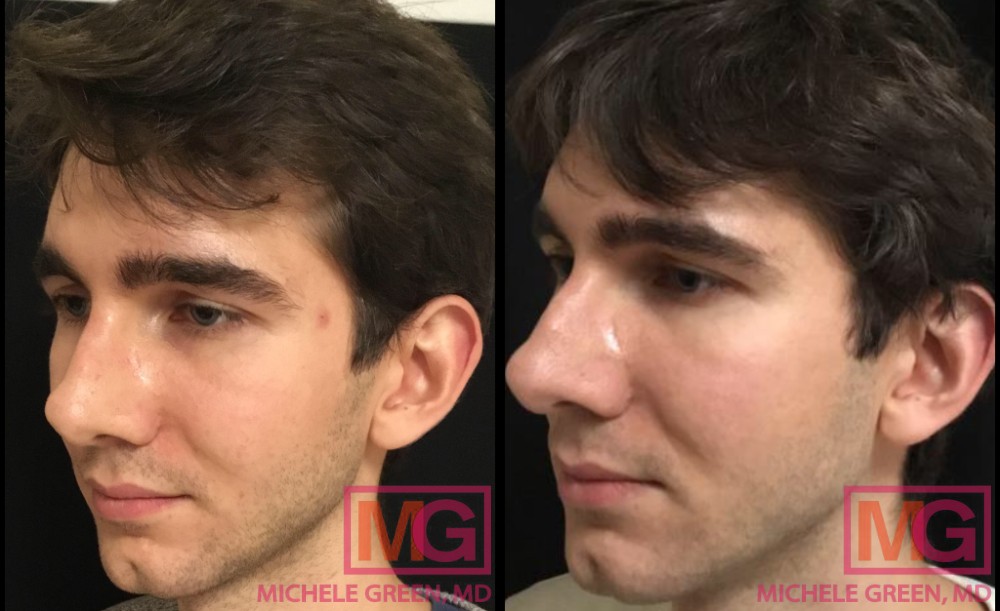
How long after Fraxel can I use Retinol?
For the week following your laser skin resurfacing treatment with Fraxel, exfoliating active ingredients, like retinol, should be avoided. Patients should also refrain from using active ingredients such as vitamin C, hydroquinone, benzoyl peroxide, and salicylic acid to avoid any irritation as the skin is healing. After treatment with Fraxel, a gentle cleanser, a non-comedogenic moisturizer, and a broad-spectrum sunscreen will keep your skin nourished and protected.
Why am I breaking out after Fraxel?
Some patients may experience acne breakouts of pimples or whiteheads following Fraxel treatment. Dr. Green recommends that patients treat the breakout as soon as possible to avoid the formation of new acne scars on the skin’s surface. Patients who have active acne breakouts at the time of the treatment should wait to receive Fraxel treatment until the breakout is resolved. If you experience a breakout of acne after having treatment with Fraxel laser, an oral or topical antibiotic may be prescribed to help clear the breakout if needed. Dr. Green has many solutions for active acne breakouts and can advise you on the treatment method that will be safe and effective. Whether acne, acne scars, or both concern you, Dr. Michele Green in NYC can help.
Can Fraxel prevent breakouts?
The Fraxel fractionated laser has many functions and can treat acne scars, hyperpigmentation, uneven skin tone and texture, stretch marks, surgical scars, and enlarged pores. However, it is not the most effective treatment for preventing acne breakouts. Dr. Green has many treatment and prevention options available at her Upper East Side New York City dermatologist office for active acne breakouts, including chemical peels, skincare products, and other laser treatments, such as the VBeam laser. When you have your initial consultation with Dr. Green, she will recommend the treatment plan that will be best to eliminate acne breakouts without causing excessive irritation to your skin.
What is the best laser for acne breakouts?
While the Fraxel is not an ideal laser for treating acne breakouts, there are other excellent non-invasive lasers available. Lasers such as the VBeam and Photodynamic therapy can reduce acne lesions in a treatment area by up to 90% with long-lasting results. The Acleara laser can reduce sebum production, eliminate acne-causing bacteria, and remove buildup from clogged pores to reduce acne. If you are experiencing acne breakouts and are looking for a laser treatment, consult with Dr. Green to find the one best for you and your skin concerns.
Is Fraxel laser worth it for acne scars?
Yes! The Fraxel laser effectively removes atrophic acne scars, improves discoloration and fine lines, and creates overall skin rejuvenation. It’s a popular and competitive treatment option for those who suffer from acne scarring, as it’s proven to reduce atrophic acne scars and, in most cases, eradicate the scarring from the skin’s surface.
The treatment works via the emission of fractional laser energy, delivered to the treatment area in many concentrated beams of light. The fractional nature of the laser means that the laser energy causes targeted damage to columns of skin, leaving the surrounding tissue unharmed. When the fractional laser energy penetrates the dermal layer of skin, it causes controlled heat damage to the tissue, resulting in micro-injuries that trigger the body’s natural healing response. When this occurs, natural collagen production occurs, leading to the formation of newer, firmer, smoother, more evenly textured skin. The treatment is safe and relatively simple, typically only taking 15-30 minutes to perform, depending on the size and scope of the treatment area. Most patients feel minimal discomfort during the treatment itself, as Dr. Green begins by applying a topical anesthetic to the treatment area, and the laser itself is equipped with a dynamic cooling device that keeps the skin from feeling too hot.
How do I get started with Fraxel treatments for acne scars?
Acne scars can be a painful reminder of previous breakouts, and often, the scars left behind are even more challenging to resolve than the initial breakout of acne itself. Luckily, non-invasive treatments such as the Fraxel laser are available for complete facial rejuvenation. The Fraxel laser penetrates deep within the skin to stimulate new collagen production, smoothing out the skin to reduce the appearance of acne scars and improve skin texture. After three to five treatment sessions, you can expect smooth, clear, radiant, and long-lasting results. Dr. Green is an expert in cosmetic dermatology, specializing in treating patients with acne and acne scars, and often employs Fraxel in her treatment plans to revitalize the skin.
Dr. Green is an internationally renowned board-certified cosmetic dermatologist, treating some of the world’s most discerning men and women with non-invasive cosmetic procedures, including the Fraxel laser for acne scars, dermal fillers, and Botox. She is consistently recognized as one of New York’s best physicians by Castle Connolly, New York Magazine, and Super Doctors due to her expertise and dedication to her patients. For each patient, Dr. Green evaluates the types of acne scars present and creates a customized treatment plan, taking a holistic approach to providing natural, beautiful results that last. If you are exhausted by feelings of self-consciousness about your acne or acne scars and are ready to eliminate the appearance of your acne scars through Fraxel laser treatment, please call Dr. Michele Green’s New York office today at 212-535-3088 or contact us online.
 212-535-3088
212-535-3088